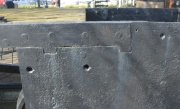Telford Footbridge at St. Katharine Docks: Difference between revisions
No edit summary |
No edit summary |
||
| Line 1: | Line 1: | ||
[[Image:JD St Kthrn Dock03.jpg|thumb|]] | [[Image:JD St Kthrn Dock03.jpg|thumb|]] | ||
[[Image:JD St K Bridge.jpg|thumb|]] | |||
[[Image:JD St Kthrn Dock05.jpg|thumb|]] | [[Image:JD St Kthrn Dock05.jpg|thumb|]] | ||
[[Image:JD St Kthrn Dock06.jpg|thumb|Note interlocking beween wrought iron members]] | [[Image:JD St Kthrn Dock06.jpg|thumb|Note interlocking beween wrought iron members]] | ||
| Line 10: | Line 11: | ||
Although it is known as [[Thomas Telford|Thomas Telford's]] bridge, a drawing dated October 1829 was signed by his Resident Engineer at the Docks, [[Thomas Rhodes]]. The maker was [[John Lloyd]] of London.<ref>Information from descriptive plaque</ref> | Although it is known as [[Thomas Telford|Thomas Telford's]] bridge, a drawing dated October 1829 was signed by his Resident Engineer at the Docks, [[Thomas Rhodes]]. The maker was [[John Lloyd]] of London.<ref>Information from descriptive plaque</ref> | ||
The bridge is assembled from wrought iron forgings and iron castings. The wrought ironwork spanning the waterway is attached to rail-mounted cast iron counterweight boxes. The rails were pitched at the standard gauge (4 ft 8½" ), or thereabouts. Movement was by rack and pinion. | The bridge is assembled from wrought iron forgings and iron castings. The wrought ironwork spanning the waterway is attached to rail-mounted cast iron counterweight boxes. The rails were pitched at the standard gauge (4 ft 8½" ), or thereabouts. Movement was by rack and pinion. If the wheels are original, they were certainly 'state of the art', being of the type fitted to several locomotives c.1830. | ||
== See Also == | == See Also == | ||
Revision as of 19:30, 14 April 2016







Moveable footbridge whose two halves could be withdrawn for the passage of vessels. Located at the entrance to the East Dock. Now preserved alongside the bridge which replaced it in 1994.
Although it is known as Thomas Telford's bridge, a drawing dated October 1829 was signed by his Resident Engineer at the Docks, Thomas Rhodes. The maker was John Lloyd of London.[1]
The bridge is assembled from wrought iron forgings and iron castings. The wrought ironwork spanning the waterway is attached to rail-mounted cast iron counterweight boxes. The rails were pitched at the standard gauge (4 ft 8½" ), or thereabouts. Movement was by rack and pinion. If the wheels are original, they were certainly 'state of the art', being of the type fitted to several locomotives c.1830.
See Also
Sources of Information
- ↑ Information from descriptive plaque

